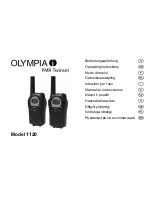
CB-320
INSTRUCTION MANUAL
PAGE
3
PAGE
2
CB-320
INSTRUCTION MANUAL
SQUELCH LEVEL SETTING ................... 17
TRANSMITTER POWER ....................... 17
VOX SETTINGS ................................... 18
POWER ON MESSAGE ........................ 18
RECEIVER (TRANSMITTER)
CTCSS/DCS CODES ............................. 19
KEYPAD LOCK .................................... 19
TO ADD OR REMOVE
SCAN CHANNELS AND
TO START SCANNING ......................... 20
DUPLEX MODE SELECTION ................. 20
CTCSS TONE FREQUENCIES .......... 21
DCS TONE CHART ......................... 21
UHF CB OPERATING
FREQUENCIES .............................. 23
SPECIFICATION ............................ 24
CONTRACT WARRANTY
AGAINST DEFECTS ....................... 25
SAFETY INFORMATION
The CB-320 is a radio transmitting device.
y
When transmitting, keep the antenna more than 25 mm from any part of the head
or body.
y
Do not transmit near electrical blasting equipment or in explosive atmospheres.
y
Do not allow children to operate a radio transmitter unsupervised.
IMPORTANT INFORMATION CONCERNING UHF CB RADIO
The use of the Citizen Band radio service is licensed in Australia by the ACMA Radio
communications (Citizens Band radio Stations) Class Licence and in New Zealand by
the Ministry of Economic Development New Zealand (MED). A General User Radio
Licence for Citizens Band radio and operation is subject to conditions contained in
those licences.
The class licence for users and equipment operating in the CB/PRS 477 MHz band
has been amended. This radio meets the new 80 channel standard.
In simple terms the same amount of spectrum is available; however, radio transceiv-
ers can now operate in a narrower bandwidth and hence use less spectrum. These
radios are generally referred to as narrowband or 12.5 kHz radios. By using 12.5 kHz
channel spacing instead of 25 kHz, the 40 channels originally allocated can now be
expanded to 80 channels thereby doubling the channel capacity and relieving con-
gestion in the UHF CB/PRS band.
Original 40 channel wideband radios will continue to operate on the original 40
channels, however they will not be able to converse on the newer channels 41 –
80. The newer narrowband radios will be able to converse with all older 40 channel
wideband radios on all channels 1 – 40 as well as the newer channels allocated
from 41 – 80.
The mixing of narrowband and wideband radios in the same spectrum can cause
some possible operating issues of interference and varying levels of received volume.
POSSIBLE ISSUES
When a new narrowband radio receives a transmission from an older wideband radio
the speech may sound loud and distorted – simply adjust your radio volume for best
performance.
Содержание CB-320
Страница 1: ...6KM KM 3WATT TWO WAY CB RADIO INSTRUCTION MANUAL CB 320...
Страница 16: ...PAGE 28 CB 320 INSTRUCTION MANUAL...



































